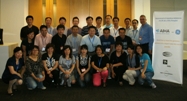
Taking Occupational Hygienist Training to the World
Many organizations contributed to the recent presentation of a training module in Shanghai for about 25 students. The goal of the new Occupational Hygiene Training Association is to take the courses to the developing world as an international certification is developed.
An exciting development for the industrial hygiene profession was completed July 2 when a weeklong course about hazardous materials monitoring finished in Shanghai, China. The course, taught in Mandarin with course materials in English, is the first of seven modules developed expressly to build EHS and occupational hygiene capacity throughout the world.
"There's just not enough capacity or technical capabilities out there for people to be able, even if they want to do the right thing, to do the right thing," said Mark Katchen, CIH, the course director and managing principal for The Phylmar Group, Inc. of Los Angeles. "China's probably farther along the path than a lot of people think, in certain cases. Because of all the multinationals in there, there is some capacity. I'll give you an example: In all of China, with 1.3 billion people, there are a total of 13 certified industrial hygienists in the entire country."
The American Industrial Hygiene Association has targeted India, China, and Mexico for its international development program, said Katchen, who is a past chair of AIHA's International Affairs Committee.
During a July 29 phone interview, he said the courses were developed thanks to a $150,000 grant from BP. Energy companies and pharmaceutical companies realized several years ago that this knowledge gap existed, said Katchen. An Australian university developed the modules as shareware that is free for use by anyone who qualifies as a training provider. AIHA then sought help from sponsors, including GE. The Occupational Hygiene Training Association has been formed as part of the International Occupational Hygiene Association to deliver the training to the developing world.
The recent training took place at a GE technical center in Shanghai. Students in the class work for GE, Nike, Converse, ITT, GlaxoSmithKline, and United Technologies, among others, Katchen said. "The GE folks were very supportive and they want to continue, is the indication. The feedback we got from the 25 students was very positive," he said. "The goal here would be, once things get up and running, is maybe have somebody out in the field, maybe within 14 months, to teach all seven [modules]." Most of the students had environmental expertise, but few possessed IH expertise because just a few Chinese universities offer hygiene programs, he said.
The British Faculty of Occupational Hygiene (BFOH) has developed an exam for each module. Katchen said this may lead to the first globally recognized certification for occupational technicians/technologists because BFOH, the American Board of Industrial Hygiene, and the Canadian Registration Board of Occupational Hygienists have signed a memorandum of understanding to work toward a common platform for such accreditation or certification.
"The idea is to try to build capacity quickly," he said, "as opposed to taking four to six years."